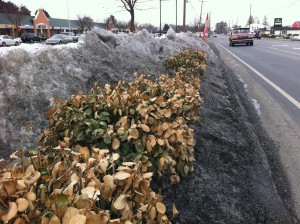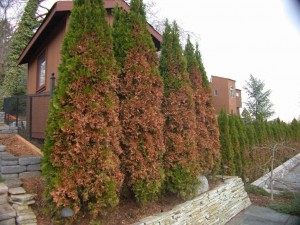A Salty Problem
March 10th, 2014
You’ve no doubt heard about how all of the road salt spread this winter by state and local road crews strained budgets.
By one estimate, highways are treated with up to 80 tons of salt per lane per mile in a back-to-back-to-back-snow season like this one.
That’s a heckuva lot of salt when you add up all of the dumpings on all of our roads.
The salt took care of the important job of making roads safer to travel – pretty quickly, too. But it doesn’t all just innocently disappear.
Salty residue runs off into streams, and it corrodes bridges and car under-carriages. Less known is the damage it does to plants.
That’s something we’re going to have to watch in the coming weeks and months.
Winter salt-spreading affects plants in two main ways.
One is directly, such as when plows and passing cars spray salty slush onto roadside plants.
Especially with evergreens – many of which are salt-sensitive – that can lead to brown needle tips and even complete brownouts of whole sections.
I’ve seen some pretty obvious cases in past years where only the road side of a stand of arborvitae turns brown – and only from the ground up to about 6 feet.
The second problem is more insidious. It involves salt building up in the soil and causing later, less-obvious damage in the form of stunted growth, leaves that brown around the edges, leaves that color early in fall or drop prematurely, and even “witch’s brooming” – clusters of deformed, twiggy growth on trees and shrubs.
Excess salt ends up in soil when salted snow and ice gets plowed or shoveled onto lawns and landscaped beds.
It can also build up to problematic levels when salty runoff drains onto lawns and beds.
Morton Arboretum research in Chicago found that salt damage to plants can occur 400 or more yards away from roads. The biggest problems are within 30 to 50 feet of roads.
“Salt can really move and do tremendous damage to both root systems and stems,” says Vincent Cotrone, a Penn State Extension urban forester in Luzerne County.
In the soil, excess sodium chloride reduces roots’ ability to take up water. That’s why the leaf and needle symptoms look a lot like drought injury – browning at the tips and margins.
In high enough levels, salt draws moisture out of the root cells.
Another problem is that salt harms the soil structure by binding with clay particles to make the soil more compacted. With less pore space in the soil, oxygen levels go down and drainage is impaired.
That’s how salt can contribute to long-term stunted growth that’s really hard to trace to salt load from winter.
Salt-related compaction is worst in the clayish soils common around here.
Our saving grace is that we usually get enough spring rain to wash salt-spray drift off of plants and leach salt buildup out of root zones.
That’s what we can really use this spring, given the higher amounts of salt that got dumped.
With salt, damage goes up both with higher amounts and longer exposure to it.
In other words, the worst combination is a lot of salt in winter, then limited rain in spring, then a hot, dry summer.
You’ll notice some salt damage fairly early in a new growing season.
First up is that road-side browning on evergreens.
Second is leaf-margin browning on the young leaves of trees and shrubs near roads.
The longer-term, harder-to-connect injuries are things like summer browning of leaf margins, browned-out lawns, early-fall leaf coloration and dropping and witch’s-brooming.
Those tend to get blamed on summer heat and drought, disease, herbicide spray drift and lousy soil.
True, those are all possibilities, too. But salt in the soil is at least a contributing factor to some of that “summer damage.”
That brings us to the matter of what we can or should do at this point.
Tops on my list is hoping for a few good winter-ending and early-spring rains.
Barring that, take a look at your roadside plantings. If you notice any white salt residue on the needles and branches, give them a good, stiff hosing. That’ll mitigate direct salt-spray damage.
To mitigate excess salt in the soil, a deep end-of-winter soaking or two will aid nature’s rains.
Cotrone says it takes a good flushing with 4 to 8 inches of water to desalinate the top 4 inches of soil.
Virginia Tech University advises soaking with 2 inches of water over a 2- to 4-hour period (assuming it’s filtering in and not running off).
Some plants are more sensitive to salt than others. See the list at the end of this for both salt-tolerant and salt-sensitive species.
Most landscape plants are OK with moderate salt levels of 1,000 to 2,000 parts per million.
Besides watching for the symptoms above, the only way to know for sure if your soil is over that is to test it.
Do-it-yourself, mail-in Penn State kits are available at county Extension offices, most garden centers or online at http://agsci.psu.edu/aasl/soil-testing/soil-fertility-testing.
Note that the standard $9 test fee just covers the basic nutrients and a pH reading. The test for soluble salts is additional and costs another $5.
Also be aware that readings can vary a lot between end of winter when the load is likely highest and later in spring after rain has diluted a good bit of it.
It’s good that we usually head in that direction, but it’s bad that plant damage can occur before rain comes to the rescue (assuming it does).
Another little aid is applying granular or powdered gypsum (calcium sulfate) to the soil before watering or before a rain. The calcium ions in gypsum elbow their way into the sodium ions from the excess salt and help uncompact the soil.
Calcium in lime can do the same thing, but lime will raise your soil pH (something you may not want, especially around acid-preferring plants). Gypsum mitigates salty soil without messing with your soil’s acidity level.
Long-term, consider these five approaches to head off future salt problems:
1.) Avoid planting salt-sensitive species along roads. Stick with salt-tolerant ones there – particularly along the first 50 to 60 feet.
2.) Improve the soil with compost before planting (to reduce the clay percentage and maximize drainage), and plant in slightly raised beds that are less prone to catching salty runoff.
3.) Don’t over-fertilize in salty beds. Fertilizers contain salts, too, and they can make a problem worse, say, if you think that stunted growth and browned-out leaf damage is a result of poor soil nutrition. Only fertilize if you really need it, and never more than necessary. Again, that soil test will give you information.
4.) Erect a burlap barrier next winter to limit plows and cars from splashing salty slush on your roadside plants.
5.) For your own snow-melting on driveways and sidewalks, switch from rock salt to more plant-friendly calcium chloride, potassium chloride or best of all, calcium magnesium acetate (CMA). Or use gritty materials such as sand or wood ashes to at least improve traction. Or shovel, blow and/or scrape the frozen stuff off (i.e. “elbow grease”).
(For more on winter damage to landscape plants and what you should and shouldn’t do about it, check out a piece I wrote on “Healing Your Winter-Damaged Yard.”)
(For a look at how stinkbugs and other bugs fared in the cold winter of 2013-14, check out a piece I wrote called “Don’t Kiss Those Stinkbugs Goodbye Yet.”)
Salt-Tolerant Plants
Trees/Shrubs: American fringe tree, American holly, arrowwood viburnum, ash, Austrian pine, baldcypress, bayberry, beautyberry, blackgum, Bosnian pine, butterfly bush, Colorado blue spruce, cryptomeria, elm, forsythia, ginkgo, golden rain, hawthorn, hedge maple, hickory, honeylocust, horsechestnut, hydrangea, inkberry holly, Japanese black pine, Japanese tree lilac, Japanese white pine, juniper, Kentucky coffeetree, larch, lilac, mountain laurel, mugo pine, potentilla, pyracantha, red chokeberry, rose, Siberian peashrub, St. Johnswort, sumac, summersweet, spirea, snowberry, sweetbay magnolia, sweetgum, trumpet creeper, white oak, willow, witch hazel, zelkova.
Perennials: armeria, artemisia, astilbe, baptisia, beebalm, black-eyed susan, butterfly weed, campanula, candytuft, columbine, coralbells, coreopsis, daylily, dianthus, feather reed grass, fountain grass, gaillardia, globe thistle, hardy geranium, hardy ice plant, hosta, iris, ivy, lavender, liriope, muhly grass, New York aster, northern sea oats, prickly pear cactus, Russian sage, sea holly, scabiosa, sedum, stokesia, switchgrass, veronica, yarrow, yucca.
Salt-Sensitive Plants
American honeysuckle, arborvitae, azalea, beech, blue atlas cedar, blueberry, cherry, coralberry, cornelian cherry dogwood, crape myrtle, dawn redwood, filbert, fir (most), fothergilla, hackberry, hemlock, hophornbeam, hornbeam, Japanese maple, katsura, linden, mimosa, New Jersey tea, ninebark, Norway spruce, pin oak, privet, red oak, red maple, redbud, rhododendron, scarlet oak, sugar maple, Swiss stone pine, tulip tree, viburnum (most), white pine.
Sources: Virginia Tech University, Morton Arboretum, New York Botanical Garden, Purdue University, White Flower Farm.









